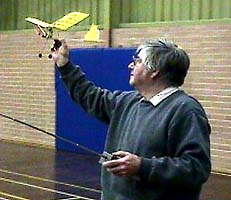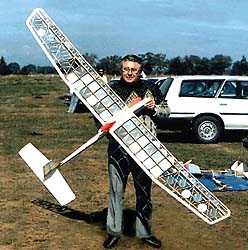
|
|
This page will discuss, in some detail, the technicalities of model aeroplane design, construction and flying. It is aimed at the more experienced modeler rather than the beginner and will assume a good knowlege of the hobby. Submissions of similar articles to the one below are welcome.
"[Here are the] Details of my RC Hangar Rat. The standard construction is as per plan, less rear liftstruts and shorter nose due to weight of electric motor giving a total weight 28 grams with motor and rudder control. The motor is a Kenway KR1-D fitted with a 4.2:1 reduction gear driving a six inch Cosmo C15 plastic prop which has been lightened and balanced. The current draw static is 0.54 amps. Battery power two x 50 Mah Nicads 7.6 g or two x 100 NiMh 6.8g. The receiver is a super regen on 27 MHz regulated at 1.6 volts and using surface mount construction. The weight is 1.6 g and the output is via a dual op amp which selects the combination of motor on /off and rudder. Motor power is controlled by a preset 10 ohm resistor which sets the idle speed and a power feed from the receiver. With this arrangement full power results in a climbing R/H 20 ft circle, idle, slightly descending R/H circle of 50 ft. The rudder is operated by Flexinol Muscle Wire, 37 microns dia., 40 mm long with a resistance of 27 ohms and force of 20 g. Wire is positioned in fin, and when the current is applied contracts pulling rudder to the left in about 12 ft circles to the left. Transmitter is a modified ACE Galloping Ghost with modulation control switch. Control sequence:
Pulsing modulation = Motor Full Rudder Neutral. Full modulation = Motor Full Rudder left.
Normal flight pattern is:
Reduce power to idle to control height or change direction to right. Full Modulation applied to turn left.
With the use of surface mount components and receivers using CPU's very light systems are possible. I currently fly using a seven channel RX with electronic speed controller that weighs 3.5g without leads."
[ click the image to download a larger version ]
The 'Solar Lady' has a wingspan of 96in, 12in chord and weighs 4 1/2 Lb. The wings are covered with clear laminating plastic film. Power is derived from solar power cells in the following combination, 24 x 1.3 amp, 24 x 1/2 amp, 12 x 1 amp. They are connected in series/parallel for a total 30 Watts (10 volts at 3 amps or 5 volts at 6 amps). The cells normally charge the battery, but can be connected directly to the electric motor. The electric motor is a geared 2.8:1 Graupner 600BB 8.4V driving a 12 x 10 in folding prop. The battery is made up of 5 x 2000 Mah Nicads. The model is controlled with a Futaba 7 Ch Transmitter using rudder, elevator, electronic speedcontroller, and u/c switch to connect cells directly to the motor. The speed controller supplies five volts for the receiver and servos, and has a resettable low voltage cutout to the motor allowing for the motor to be used after the cells have topped up the battery. The model has a few problems: When the cells start producing power they heat up, this has the effect of reducing the terminal voltage and condensation forms on the inside of the wing covering material for a period of time. Solar cells only supply full rated power at right angles to the sun, which is a bit hard to arrange when flying. The cells are sixteen years old and are of a design that is only 12% efficient, and the model weight of 4 1/2 Lb does not help. The longest flight so far is 1 hr 45 min.
|
© Copyright 1999 CTIE - All Rights Reserved - Caution |
 Our first modeler,
Our first modeler, 